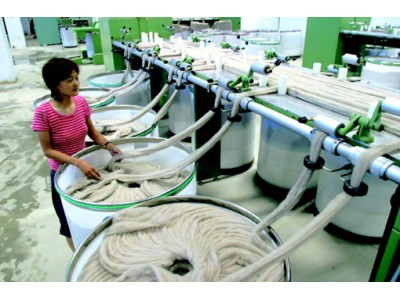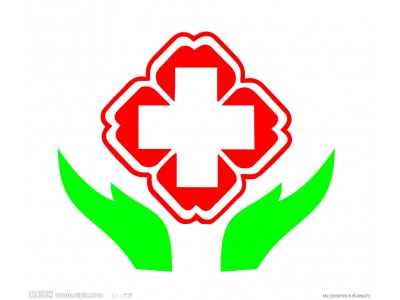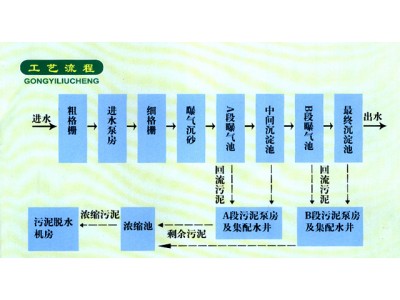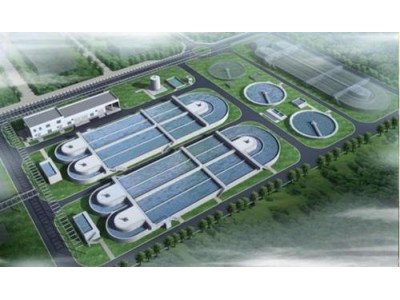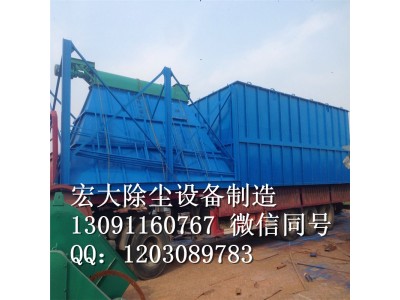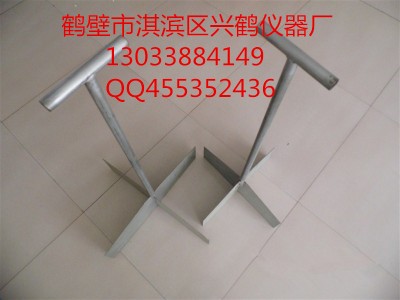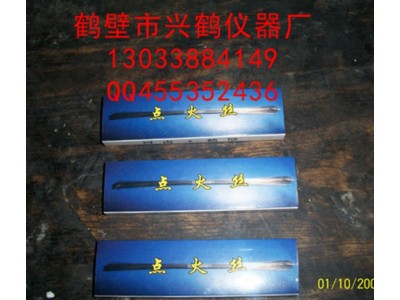摘要:交替式生物处理池工艺(UNITANK)是结合传统活性污泥法和SBR法的优点形成的一种新型的活性污泥处理工艺,由三个矩形池串联组成(A,B,C池),池内设曝气设备。交替式生物处理池按周期进行,B池连续曝气,两侧池内间断曝气,交替作为沉淀池和曝气池,进水交替进入A、B、C池,出水相应地从C、A池引出。系统中省去传统工艺中的初沉池和污泥回流设施
关键词:交替式生物处理池 UNITANK城市 污水
石家庄高新技术产业开发区污水处理厂日处理污水10万吨,采用UNITANKTMIM工艺,占地7.2公顷。这是此工艺在国内(除澳门外)的首次应用。该污水处理厂进水水质指标为:BOD5≤400mg/L,SS≤400mg/L,COD≤600mg/L;出水水质要求:DOD5≤30mg/L,SS≤30mg/L,COD≤120mg/L。
处理工艺过程为:原污水进入格栅间,在此拦截污水中飘浮物,由污水泵提升,经细格栅进一步去除水中杂质,进入沉砂池去除砂粒,然后进入UNITANK池,去除BOD5等污染物,混合液经沉淀分离,澄清液进入接触池加氯消毒(季节性)后排入汪洋沟。剩余污泥经污泥泵送至集泥池,由带预浓缩功能的脱水机处理后,泥饼外运。
该污水处理厂UNITANK 池共为六个组,每个组由三个正方形反应池组成,单池净尺寸为长×宽×高=35×35×7m,有效水深6米。两侧池采用周边堰出水。每组平均设计流量为 0.193m3/s,污泥浓度4000mg/l,泥龄为14天,污泥负荷0.113kgBOD/KgMLss/d,沉淀池最大表面负荷0.74m3/m2h。
该系统实际需氧量为60吨O2天。系统采用表曝机和潜水搅拌机结合的方式,表曝机运行充氧,水下搅拌机用于辅助搅拌。表曝机选用浮动式高速表曝机,可适应水面起落,安装简单,维护方便。
UNITANK工艺据有独特的优点:第一,结构紧凑,节省工程用地和土建费用;第二,设备种类较少,便于维护管理;第三,采用时序控制,形成厌氧、缺氧和好氧状态,实现除磷脱氮功能,运转灵活;第四,容积和设备利用率高。
UNITANK工艺虽有许多优点,但也有一定的适用范围。在选择该工艺时应该考虑以下问题:
第一,进水BOD浓度较高时,建议考虑采用两级UNITANK工艺。第一级生物池按高负荷厌氧或好氧方式运行,第二级按低负荷好氧方式运行。
第二,出水水质有除磷要求时,应慎重考虑,因为该工艺很难形成生物除磷的理想厌氧状态。
第三,处理水量过大时,该工艺的复杂程度将大大提高。
综上所述,UNITANK工艺更适用于中小型污水处理厂,在一定的范围内,可以替代其它活性污泥法,有独特的优点,并具有较强的竞争力。
Abstract:The altemative biological treatment (UNITANK®) is a new combination of advantages of traditional activated sludge process and SBR. It consists of one rectangular reactor which is divided in three compartments (basin A,B,C). Each compartment is equipped with an aeration system. The process works according to a cyclic operation. In compartment B aerated continuously, in compartment A and C ether aerated or settled, the waste water is fed to compartment A, B and C alternatively, the cleaned water is discharged form compartment C and A. There are not primary settling tanks and sludgereturn facilities that are installed in traditional process.
The wastewater treatment plant of the ShijlaZhuang Economic Zone is the first plant using UNITANK® in China except Marco. It can treat 100,000 cubic meters municipal wastewater every day and is 7.2 ha area.
The influent characteristics of the plant are as follows: BOD5≤400mg/L,SS≤400mg/L,COD≤600mg/l; The effluent discharge values will be: BOD5≤30mg/l, SS≤30mg/l, COD≤120mg/l.
The general description for the process is as follows: the raw wastewater is collected in the inlet pump station, big suspending materials will be retained by means of coarse. After inlet pump lift, the raw water flow through fine screens, small suspending materials removed. In the grit chamber, the sand is reactions of micro-organisms, the substances such as BOD, are degraded. After the grit chamber, the sand is removed from the raw water. Then, the water flow in the UNITANK® . Using the metabolic reactions of micro-organisms, the substances such as BOD, are degraded. After biological treatment, the sludge settles by gravity, the clean water is disinfected seasonally and finally discharged to Wangyang River. The excess sludge is pvmped to the sludge storage tank in which the sludge is stored temporarily, and then is thicken by means of mechanical sludge dewatering.
There are six lanes for this project. each of them consists of three compartments which size is 35 meters long, 35 meters wide and 7 meters high, and 6 meters water deep. In compartment A and C, there are overflow weirs around basins. Each lane has a average capacity of 0.193m3 of waste water per day. The average sludge concentration is 4000mg/l. The average sludge loading is 0.113kgBOD/kgMLSS/d. The sludge age is 14 days. Maximum surface loading is 0.74m3/2h when the compartment A and C are used as settling tank.
For this project, the actual oxygen demand is 60000kg/d. The aeration system consists of surface aerators and submersible mixers. The aerators areate aerobic conditions, the mixers keep sludge suspending and enhance oxygen uptake. Because the aerators are floating type,so they can adapt to the water surface up and down. and easy to install and maintenance.
UNITANK® have their particluar advantages: First, it is construction-compact, spacesaving and costeffective. Second, it is small kinds of equipment and easy to maintenance. Third, control in time can performs the anaerobic, anoxic and aerobic conditions in a same compartment, and realizes or enhances biological nutrient removal. Fourth, it has high usage ratio for equipment and construction volume.
Though the process has many advantages, it also has its own usage scope. When selecting the process, we suggest to consider the following items:
First, if the influent BOD value is very high, it is better to select two-stage UNITANK®system. The first stage is operating under high loading and anaerobic or aerobic conditions, the second stage is operating under low loading and aerobic conditions.
Second, if there is effluent phosphorus demand, it should be pay attention to select the process, because it is very difficult to produce the ideal anaerobic condition for biological phosphorus removal.
Third, if the treatment capacity is pretty high, the operation control system for the process will be very complex.
About all, UNITANK® has many particular advantages. It is suitable for wastewater treat ment plant on a small or medium scale. In certain scope, it can take place of many other activated sludge processes.
自1987年,比利时SEGHERS公司提出一种新颖的活性污泥去——UNITANK工艺,它集中了传统活性污泥法和SBR的优点,处理单元一体化,经济、运转灵活,在欧洲及亚洲已有近2百座此种工艺的污水处理厂建成。
石家庄高新技术产业开发区污水处理厂(以下简称石家庄高新区污水处理厂)日处理污水10迈万吨,经过工艺方案比较和论证,结合贷款国技术特点,决定采用UNITANK工艺。这是此工艺在国内 (除澳门外)的首次应用。
1.UNITANK工艺简介
1.1 基本构造
UNITANK又称交替式生物处理池,其基本单元是由三个矩形池组成(A,B,C池),相邻通过公共墙开洞或池底渠连通。三个池中都安装有系统,可以是微孔头、表曝机或潜水机:外侧两个池(A和C池)设有固定式出水堰及剩余污泥排放装置,他们交替作为池和沉淀池,中间的池子 (B池)只能作为反应池。另外,污水通过闸门控制可以进入任意一个池子,采用连续进水,周期交替运行。如图1所示。

1.2 运行方式
UNITANK运行按周期运行,一个周期包括两个主阶段和两个中间阶段,一般单个周期时间为7小时,主阶段2×3小时,中间阶段2×30分钟。
1.2.1 主阶段
第一主阶段,污水首先进入A池,该池处于状态,因上个阶段进行沉淀操作,积累了大量活性污泥,且浓度较高。进水与活性污泥混合,有机物被吸附,部分被降解。混合液继续流入B池,该池通 常连续,有机物得到进一步的降解,同时在推流过程中,A池的活性污泥进入中间池,再进入C池,实现污泥在各池的重新分配。最后,混合液进入处于沉淀状态的C池,进行泥水分离,处理后的出水通过溢流堰排放,剩余污泥由该池排出。为了防止A、B池的污泥被冲至C池,过量积累,每120—180分 钟改变水流方向,即进入到下一个主阶段。
第二主阶段,污水先进入C池,污水及混合液的流动方向与第一阶段相反。
1.2.2 中间阶段
中间阶段的作用是完成池到沉淀池的转换。在第一主阶段的中间阶段,污水进入B池,C池仍处于沉淀出水状态,同时A池开始进入沉淀状态,为出水作准备。在第二主阶段的中间阶段,污水进入B池,A池仍处于沉淀出水状态,同时C池开始进入沉淀状态,为出水作准备。
因为边池在状态时,出水槽内进满混合液,所以边池进入沉淀状态后,开始的出水不能作为处理后的出水直接排放,需用冲洗排人处理系统。待出水澄清后,方可外排。



